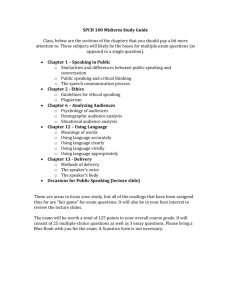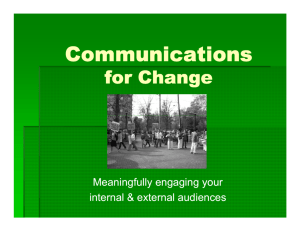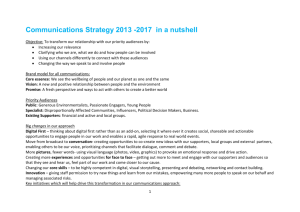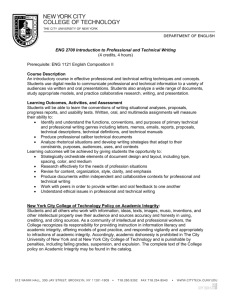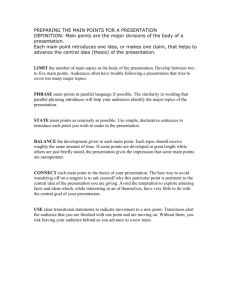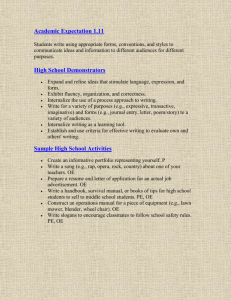- AIM Awards
advertisement
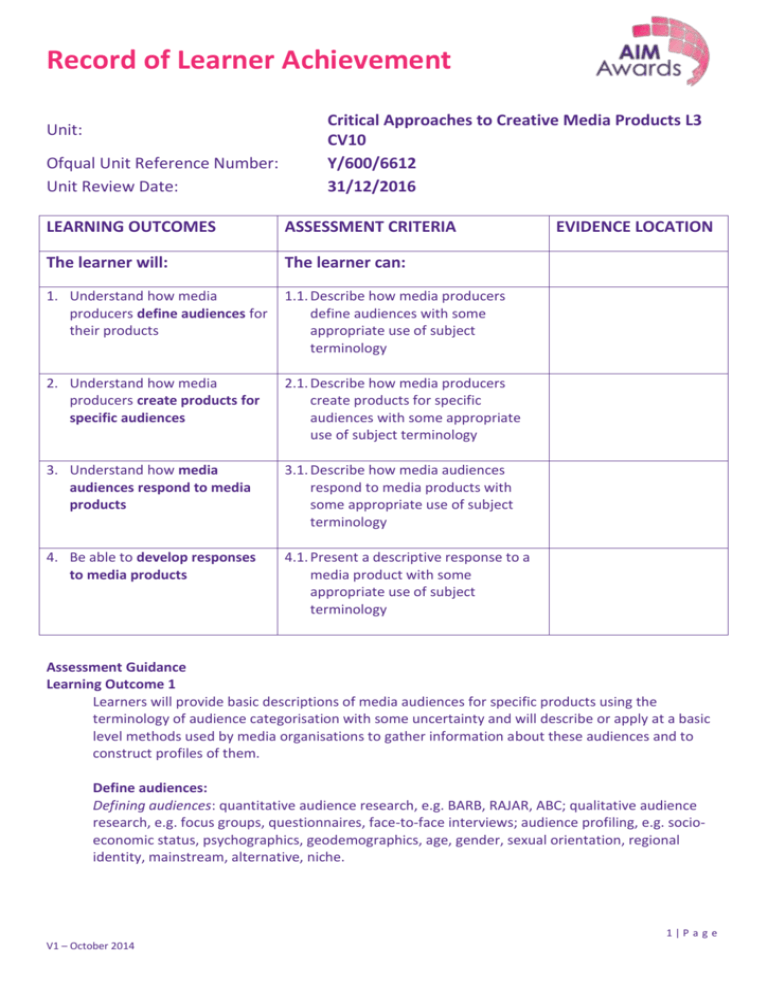
Record of Learner Achievement Unit: Ofqual Unit Reference Number: Unit Review Date: Critical Approaches to Creative Media Products L3 CV10 Y/600/6612 31/12/2016 LEARNING OUTCOMES ASSESSMENT CRITERIA The learner will: The learner can: 1. Understand how media producers define audiences for their products 1.1. Describe how media producers define audiences with some appropriate use of subject terminology 2. Understand how media producers create products for specific audiences 2.1. Describe how media producers create products for specific audiences with some appropriate use of subject terminology 3. Understand how media audiences respond to media products 3.1. Describe how media audiences respond to media products with some appropriate use of subject terminology 4. Be able to develop responses to media products 4.1. Present a descriptive response to a media product with some appropriate use of subject terminology EVIDENCE LOCATION Assessment Guidance Learning Outcome 1 Learners will provide basic descriptions of media audiences for specific products using the terminology of audience categorisation with some uncertainty and will describe or apply at a basic level methods used by media organisations to gather information about these audiences and to construct profiles of them. Define audiences: Defining audiences: quantitative audience research, e.g. BARB, RAJAR, ABC; qualitative audience research, e.g. focus groups, questionnaires, face-to-face interviews; audience profiling, e.g. socioeconomic status, psychographics, geodemographics, age, gender, sexual orientation, regional identity, mainstream, alternative, niche. 1|P a g e V1 – October 2014 Record of Learner Achievement Learning Outcome 2 Learners will correctly describe aspects of media products which address a specific audience, and they will also correctly define that audience, albeit without detail. They will not, however, be able to show how or why the aspects described are specific to the audience defined, relying rather on unsupported assertions such as, ‘The formal type of language used in The Independent appeals to middle-aged, well educated people of social groups A and B.’ Create products for specific audiences: Addressing audiences: selection of content, e.g. words, images, sound, sequences, colours, fonts; construction of content, e.g. narratives, layout, captions, anchorage; codes and conventions, e.g. linguistic, visual, audio, symbolic, technical; modes of address. Audience feedback: e.g. focus groups, audience panels, trialing and testing, reviews, complaints. Learning Outcome 3 Learners will be able to outline correctly the major audience theories (for example, the hypodermic needle model and uses and gratifications theory) but they will not apply them to specific texts with any certainty. They will correctly describe some work done on effects of the media, but any attempts to theorise effects or draw conclusions about how to deal with what are perceived as ill effects will rely on simple, unsupported assertions such as, ‘Advertisers know that their adverts have the effect of increasing sales or they wouldn’t waste their money on it, so I think advertising junk food to children should be banned.’ Media audiences respond to media products: Audience theory: hypodermic needle model; uses and gratifications theory; reception study; passive or active consumption. Effects debates: e.g. effects of exposure to explicit sexual or violent content, effects of advertising, health concerns; censorship debates. Responses: negotiated; preferred; oppositional; participatory; cultural competence; fan culture. Learning Outcome 4 Learners will outline reasonable but simple responses to specific texts employing some recognisable critical methodology. They will correctly describe the main codes and conventions of a genre and will make some attempt to address narrative and representation but they will not link these to the audience or to specific examples from the texts considered. Typically learners will be least successful when dealing with narrative conventions, and explorations of representational issues will not go beyond unsupported assertions or statements. There will be no detailed exemplification from the texts and no support for opinions, which will remain at the level of assertion. Develop responses to media products: Critical approaches: e.g. content analysis, semiotic analysis, structuralism. Genre: according to production technology e.g. film, video, audio, print, digital; distribution method, e.g. television, cinema, radio, internet, CD, iPod, mobile phone, home computer, hand2|P a g e V1 – October 2014 Record of Learner Achievement held consoles; generic codes and conventions (content, style, symbolic, cultural, technical); changes over time, e.g. in audience, ideological shifts, re-definition, obsolescence, spoof, pastiche, parody. Narrative structures: narrative, e.g. single strand, multi-strand, closed, open, linear, nonlinear; alternative narrative; enigma; climax; equilibrium. Representation: negative; positive; of social groups; of social issues; stereotyping; presence and absence. Evidence Requirements Evidence of practical ability must be demonstrated. Final Tutor Feedback (Strengths and Areas for Improvement): Learner Submission Disclaimer I declare that this is an original piece of work and that all of the work is my own unless referenced. Assessor Disclaimer I confirm that this learner’s work fully meets all the assessment criteria listed above at the correct level and that any specified evidence requirements have been addressed. Assessor Learner Date 3|P a g e V1 – October 2014

